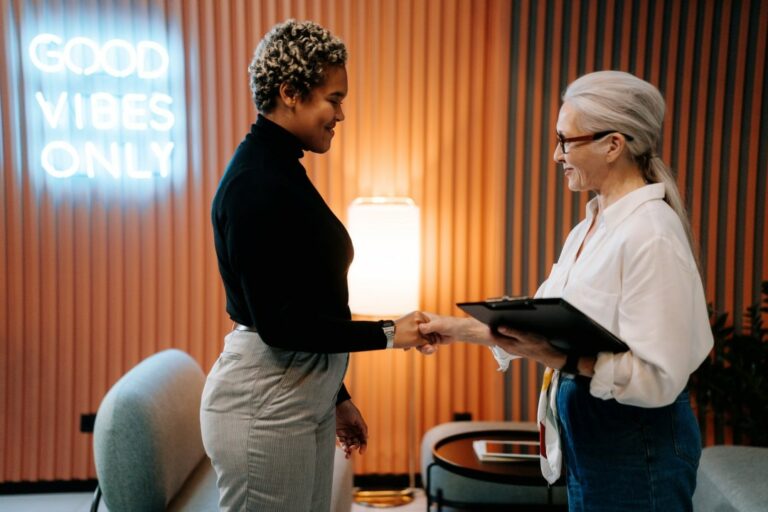When opportunity arises and we can use the services of a stylist for a production we usually call upon our trusted pool of professionals. But once in a while when time and fortune favours me, I get to let my creative streak out and put my stylist hat on. It’s a real treat for me, clothes and shopping, what’s not to love! A change to my regular job as Managing Director.
Do you really need a costume stylist?
You can make video drama without a stylist, but it’s a very nice thing to have and adds polish and sparkle to a beautifully shot drama.
If you are keen to maximise your budget and get the most effective video for your money then it’s worth investing in the right places. As Tom, our Creative Director, wrote in his recent e learning Age article, the priorities for your video drama budget come in this order:
- Script
- Actors
- Director
- Production Values
The projects I get involved in as a stylist tend to be dramas for large organisations with budget for good production values. The results can be stunning, the quality of the drama can be cinematic. The characters I dress might be executives, office workers or trades people. Whatever their role, they are characters based on real people with real lives who shop in the places you and I do, on the high street, online or work wear retailers for PPE and uniforms.
Investing in a stylist makes the characters easily believable and fitting to their environment. Attention to detail on the wardrobe helps the actor get into role through their outward appearance, their visual identity.
Yes but what does a stylist do for the money?
Most of a stylist’s work is in the pre-production stage, gathering information, researching, organising and shopping.
Interpreting the brief: It’s usually the scriptwriter who provides the character profiles which is where the job starts. The better the script and writer the more useful detail you’ll get in a character profile. Beyond the physical appearance and the job role it’s great to know about their personalities, out of work interests and the dynamics of the relationship between the characters. All this detail helps the characterisation and informs the stylist’s choices.
Get to know the actors: Once the cast has been chosen the stylist will gather recent pictures of the actors. It helps to know what colours will work on them and what looks like a natural choice. The actors are contacted to get sizes, body shapes, skin tones and see if they have any clothes they’d be willing to bring that will fit the characters.
Script analysis: The script needs assessing to check the number of story days per character. The director is consulted about the framing and shooting, where the camera is likely to be focused, will the whole body be in shot or just the head and shoulders? Are there close ups of hands, faces, etc. that need particular attention when choosing accessories?
Location: Usually the recce shots are enough to get an idea of the location and if there’s a particular colour scheme or theme in the environment. The production manager usually provides details of the company that’s to be portrayed. What do people wear in that office? What is the common dress code?
Bringing the wardrobe together: This can involve a mammoth shopping trip. All of the characters, their story days, descriptions of scenes, actors’ sizes and character profiles need to be listed and made easy to access when you’re flying round the stores imagining you are the character you’re shopping for. If you’re buying 2 or 3 choices for each character per story day it can soon mount up to an outrageous pile of shopping.
Costumes confirmed: After a quick meeting with the director and seeing what their preferred choices are, the costumes are organised into character, story days and filming order so the right clothes are to hand when a costume change is required.
On the shoot: The stylist helps the actors get into costume and runs the outfits past the director and client for approval. The clothes need to look good and be crease free so there’s lots of ironing, hanging and brushing going on. While the cast are on set the stylist keeps an eye on their costumes by watching the monitors to make sure nothing looks out of place, no labels showing or bits of fluff. The stylist is also responsible for costume continuity between scenes.
After the shoot: The glamorous side of the job – washing, ironing, packing away the used clothes and returning the unused items to store.
Summary
So do you really need a costume stylist? It depends what you want to achieve. As Tom wrote “Production values can add a lot in terms of gloss and beauty and brand values and make the video more of a pleasure to watch.” In a polished drama it’s worth investing a little extra to get this bit right. With high production values the viewer’s attention is drawn into the world of the drama and engagement is improved.
In Tom’s third e-Learning Age article he looked at production values in detail and what difference they really make, here is a link to the article. Check out the video clip showing 3 different visual styles.
- The first clip is the actors in full costume and make up against black drapes.
- The middle clip is guerrilla style with actors wearing on their own clothes on location.
- The clip at the end has the characters in full costume and make up on location.
Which do you think is the most engaging?







